Bike hubs are the central components of wheels. They may be small in size, but they are a crucial part of the bike. There are more kinds of bike hubs than you might think. We believe that all bike owners should know about all the components of a bike, including hubs. This is why we have prepared this article to give you an overview of all the different types of bike hubs available.
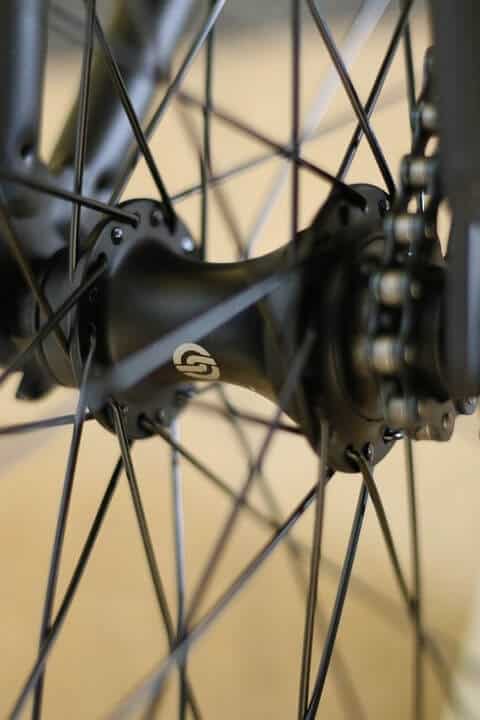
Hubs according to wheel
Front hubs
The basic structure of a front hub consists of the hub body which is a tubular shell with one set of bearings at each end. These can be either cup and cone bearings or cartridge bearings. The axle of the wheel is threaded through the hub body and spins on the bearings. The axle is then secured to the bike frame/fork via quick-release clamps or bolts depending on the hub and bike type.
The hub generally also features a raised lip called a flange at either end. The flanges have holes drilled in them where the spokes are installed. If the bike has a disc brake, then there will also be a mount for the disc brake rotor, or at least the option to have them fitted.
Rear hubs
Rear hubs have the same basic structure as a front hub, but with additional mechanisms. A lot of them will feature a freehub on the drive side. This is a splined component on which the cassette can be mounted.For older bikes with a single speed or those using a freewheel, the hub will have a thread to mount them instead of a freehub. The freehub or the freewheel contains a ratchet mechanism, most commonly spring-loaded pawls turning in a toothed gear. Other slightly different mechanisms are available as well.
This mechanism allows you to coast the bike and is the cause of the clicking sound you hear while doing so. The other purpose of this system is to engage and transfer power to the cassette when pedaling forward. The number of pawls/teeth is also important to some riders. Larger/fewer teeth can handle more torque while smaller/more teeth feel more responsive and transfers power faster.
Hubs according to riding discipline
Mountain bike hubs
Hubs for mountain bikes come in a wide range of types and sizes. This is because of the various frame/axle standards and also to suit the needs of different riding styles. For example, a cross-country racing hub will be made of carbon or aluminium and have smaller dimensions to reduce weight. While a dirt jump or downhill hub will be larger and made of steel to withstand the greater stresses involved. However, the most important thing is to match the hub width with the required axle length.
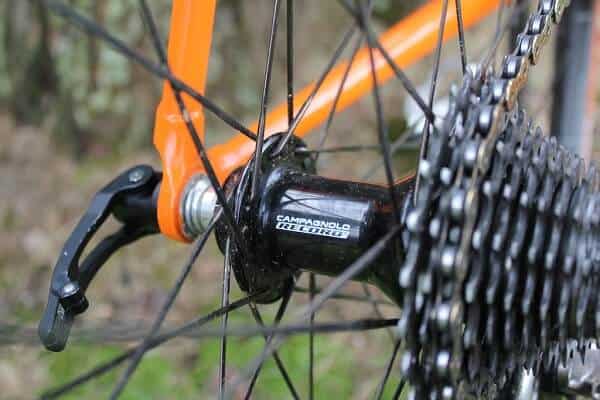
Road bike hubs
In general, road bike wheels are subject to less punishment than MTB wheels. Therefore, they are designed to be more minimalistic and lightweight. They may have fewer spoke holes for example. When manufacturers build hubs for high performance and competitive riders, they tend to use carbon fiber, more compact axles, and long-lasting, lightweight ceramic bearings in place of steel ones. However, these improvements in speed and performance come at a higher price.
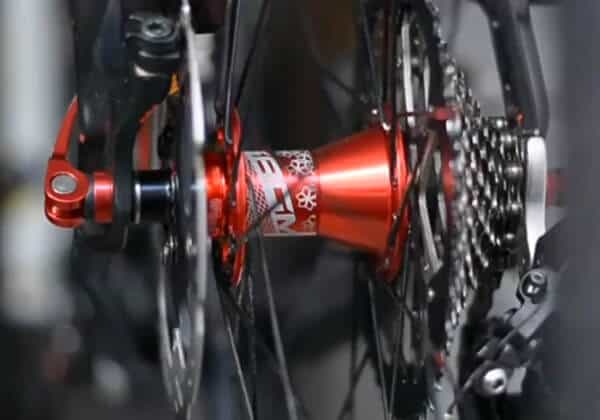
BMX hubs
BMX bike hubs usually have to be compatible with different axle sizes than MTB or road hubs which may have similar dimensions. This is mainly due to the fact that BMX bike frames are much smaller. Another way in which BMX hubs are different is that many of them may be of the singlespeed variety. Additionally, some hubs are dual sided. These are known as flip-flop hubs and are discussed below. Other than that, the bearing types and other components are similar to MTB and road hubs.
Hubs according to mechanism
Track hubs
Track hubs are the kind of hubs you can find in almost all single speed bikes. It features two stepped threads. The main thread is for the attachment of the sprocket and is similar in design to a freewheel hub. The other thread which is smaller in diameter is there to act as a lock ring. This design is quite efficient since screwing the sprocket tightly will also cause the lock ring to screw down and attach securely.
Flip-flop hubs
Also known as dual sided hubs, these are most commonly found on BMX bikes. On one side is a threading with a lock ring similar to track type hubs. The other side features a single speed freewheel. On a few rare models, flip-flop hubs may have track threading on both sides. These hubs give the option for two different speeds. However, you will have to detach the chain, remove the wheel, turn it over, and reattach it to use the other speed. You could have one setting for regular riding and use the other side when you need higher speeds.
Freewheel hubs
Traditionally, bikes with multi-speed drivetrains featured a threaded rear hub to which a freewheel can be mounted. The freewheel contains the different sized sprockets and the ratchet mechanism that makes coasting possible. If one of the sprockets gets worn out, you can simply unscrew the sprockets from the freewheel and replace the specific one. With freewheel hubs, any brand of freewheel can be mounted on any brand of hub. Freewheel hubs can still be found in bikes but have become far less common.
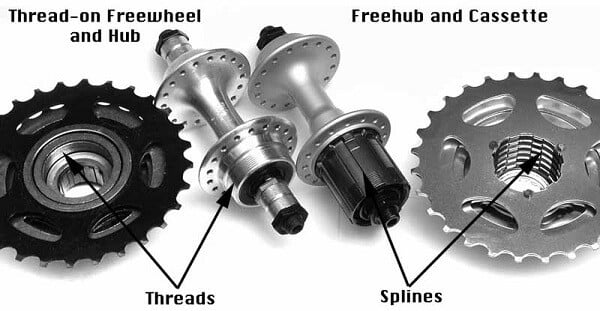
Freehub and cassette
The freehub and cassette system has largely replaced freewheel hubs over the last few years. People often get the two confused. We have already described how a freewheel hub works. In contrast, a freehub is a component built onto the hub on the drive side. This is a splined metal part containing the ratchet mechanism that allows coasting. A cassette with multiple sprockets is slid onto the splines and held in place by a lock ring. The advantage of this system is that when the sprockets get worn out, you only have to replace them and not the entire ratchet mechanism which can last a lot longer.
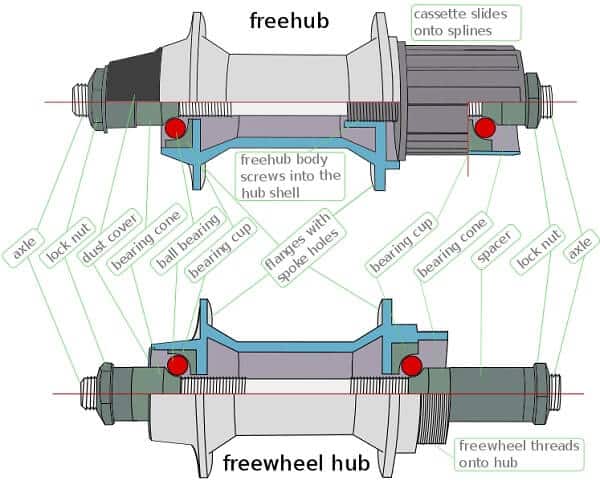
Frequently Asked Questions
Q1. What are points of engagement?
Ans.: The number of points on the freehub mechanism where the cassette is engaged while pedaling forward is known as points of engagement. Usually shortened to POE, this number depends on the number of teeth and also the number of pawls if present. Higher-end hubs will typically start from 36 POE and increase from there. Meanwhile, cheaper hubs have less POE, typically in the range of 18 to 24. As mentioned before, less POE can handle more torque while more POE feel more responsive and transfers power faster.
Q2. Which type of bearing is better for bike hubs?
Ans.: There are two types of bearings found on bike hubs – cup and cone bearing and cartridge bearings. Cup and cone bearings are the older design and are also more affordable. They can be serviced at home but handling the loose ball bearings can be tricky and adjusting them perfectly can be difficult. Cartridge bearings are more convenient when it comes to servicing them. They also offer slightly better performance. However, they are more expensive.
Conclusion
As you can see, there are actually quite a large variety of bike hubs out there. They look simple from the outside, but in reality have slightly complicated mechanisms. Now you should be able to confidently go out looking for a new hub and know that you can make the right decision according to your needs.
